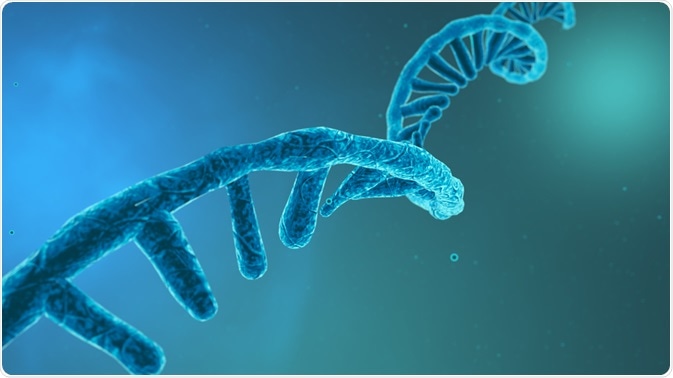Non-coding RNA (ncRNA) is a gene transcript that does not correspond to a protein. This includes micro RNA (miRNA), circular RNA (circRNA), long non-coding RNA (lncRNA), ribosomal RNA (rRNA), and transfer RNA (tRNA), among others.

Image Credit: CROCOTHERY/Shutterstock.com
Some types such as miRNA, circRNA, and lncRNA have regulatory roles, controlling the level of mRNA in the cell. Others, like rRNA and tRNA, have key roles in housekeeping, ensuring amino acids are added in the correct sequence to correspond to the mRNA being translated.
These ncRNAs make up around 90% of the genome, so are a key area of study to understand the regulatory processes that occur in cells, with proteins providing only a small but important role in these processes.
Roles in translation
rRNA and tRNA are two of the more well-studied types of ncRNA in the cell, due to their role in the formation of proteins.
rRNA associates with ribosomal proteins to form ribosomes. The proteins help to maintain the structural shape of rRNA, increasing its stability. It is the main actor in translation, forcing tRNA and mRNA to assemble proteins. It is also the most common form of RNA in the cell, representing 80% of all cellular RNA.
tRNA strands associate with a single amino acid, binding a specific mRNA codon. As the mRNA strand is ‘read’ by the ribosome, amino acids bind together to form a polypeptide chain where tRNA binds mRNA at the active site of the ribosome. The polypeptides fold and form proteins, often with multiple polypeptide units.
Another role that ncRNA plays in translation is the role of small nuclear RNA (snRNA) in transforming pre-mRNA into mature mRNA. snRNA associates with protein molecules to form snRNP which binds pre-mRNA and catalyzes the removal of introns from the pre-mRNA sequence, leaving fully functional mRNA.
Roles in the regulation of translation
ncRNAs are a key factor in inhibiting the expression of proteins. An important part of this role is in post-transcriptional regulation by destabilizing or degrading mRNA strands before translation.
This is carried out by micro RNA (miRNA) by cleaving the mRNA strand into two, destabilizing the strand via its poly(A) tail, or a mixture of both. This acts as another level of gene regulation on top of the pre-transcriptional regulation of DNA.
The activity of miRNA is controlled by a group of ncRNAs known as competing endogenous RNA (ceRNA). They include circRNA, lncRNA and pseudogenes, and bind miRNA response elements (MREs) on miRNA, acting as ‘sponge transcripts’ to prevent the inhibition of mRNA translation.
The equilibrium between ceRNA, miRNA, and mRNA is an important factor in the post-transcriptional regulation of genes and controlling the up- or down-regulation of certain proteins. Changes to this balance are key in age-related cardiovascular disease.
Another RNA, small interfering RNA (siRNA) also acts to silence mRNA post-transcriptionally. It is formed from the cleavage of long double-stranded RNA to leave the small single-stranded siRNA.
siRNA then associates with specific proteins to form an RNA-induced silencing complex (RISC). When the siRNA then binds a complementary mRNA strand, which is then cut by RISC activity, preventing the mRNA from being translated.
siRNA is much more specific than miRNA, complementing the mRNA target perfectly so that splicing can occur. They also differ in that siRNA acts to prevent translation by silencing mRNA, whereas miRNA acts to inhibit translation by competing with rRNA and tRNA for mRNA binding.
Roles in the regulation of transcription
An important ncRNA in maintaining the integrity of the genome is PIWI-interacting RNA (piRNA). Once transcribed piRNA associates with PIWI proteins are re-enters the nucleus. They constitute the largest class of ncRNAs.
The principal role of piRNAs is to prevent the transcription of transposable elements in the genome by initiating gene silencing machinery to inhibit transcription of the target gene. This reduces the effect of these elements on the overall integrity of a cell’s DNA.
circRNA has also been shown to have a role in both the initiation and elongation steps of transcription. In the initiation phase, recent evidence suggests EIciRNA associates with snRNA and DNA polymerase II at the target site, causing the upregulation of the target gene.
The implication of circRNA in the elongation phase has recently also been identified. circRNA has been shown to associate with phosphorylated DNA polymerase II (phosphorylation is key in the elongation of the mRNA transcript), however, the specific regulatory role it plays is still unclear.
Conclusion
Significant steps have been taken to understand the wider role of ncRNA in the cell, however, there is still a lot that isn’t understood. A deeper understanding of this area may play an important role in the future of molecular medicine.
Understanding the function of ncRNAs is essential to understanding many of the regulatory processes in the cell, particularly those related to transcription and translation. Future therapeutics may be based around improved knowledge of ncRNAs.
References
- Bose, R. and Ain, R. (2018) ‘Regulation of transcription by circular RNAs’, in Advances in Experimental Medicine and Biology. doi: 10.1007/978-981-13-1426-1_7.
- Hansen, T. B. et al. (2013) ‘Natural RNA circles function as efficient microRNA sponges’, Nature, 495(7441), pp. 384–388. doi: 10.1038/nature11993.
- Yang, J. X., Rastetter, R. H. and Wilhelm, D. (2016) ‘Non-coding RNAs: An introduction’, in Advances in Experimental Medicine and Biology. doi: 10.1007/978-94-017-7417-8_2.
Further Reading